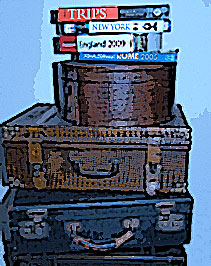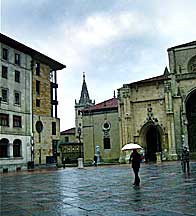
...here we go a-wandering...traveling is the delight of the soul...
Travelogue by Chris Ciolli
Asturias is the only region of Spain Ive visited that immediately brings Ireland to mind. Lusciously green and notoriously rainy, even the pearly, luminescent quality of the light filtering through the clouds makes me think of Ireland. Flying into the the airport at Asturias, I briefly regret living in Barcelona among so many palm trees.
On the bus ride to Oviedo, I grumble to myself about the limitations not having a Spanish drivers license presents. Buses and trains are nice, but arent always convenient for vacationing outside reasonably sized cities.
I frown and sigh longingly at the hills scattered with colorful houses and farmland rushing past the window glass. In the end, its much better than focusing on the teenage couple seated directly in front of me, who are loudly smacking their lips around sandwiches, never quite closing their mouths and talking a mile a minute.
When an hour later, I arrive at the Oviedo bus station, its time to get oriented, and dump my luggage at my lodgings, El Hotel Vetusta. As is the case with most of the hotels Im willing to pay for, my hotel room is tiny and barely contains its double bed, but is very clean and includes a private bathroom and a breakfast of caf con leche and a sandwich or pastry.
"Vetusta" means "old" or "ancient," but the hotels name is most probably a literary reference. The Asturian author, Leopoldo Alas Clarin, based his fictional city, La Vetusta, on Oviedo in his classic novel, La Regenta, the story of Ana, a young woman married to a fussy man many years her senior and her subsequent infidelities. Think Madame Bovary, al espaol.
As can be expected in a city that receives rainfall on average every other day, a light mist is falling. But a few errant drops have never been a sufficient deterrent to keep me from sight-seeing. So, after strewing my things about the room to give it a homey feel, and getting a city map at reception, Im out the sliding door.
 Woody Allen: to see or not to see...that is his philosophical question.
Woody Allen: to see or not to see...that is his philosophical question.
Oviedo is home to various world heritage sites and monuments, but my first stop is a life-sized bronze statue of Woody Allen. Standing there, in his habitual slouch, somethings off. Ah, it appears someone must have had their eye or hands on Mr. Allens glasses, and broken them off, a habitual occurrence. Oddly enough, sculpted Woody seems to squint, as if he werent metal at all, and was irritated to have his people-watching impeded by limited visibility.
The director of Annie Hall holds a special place in Oviedans hearts. Why? It's because of the praise he heaped on the city after visiting to accept an award. Allen said, "Oviedo is delicious, exotic, beautiful, clean, pleasant, peaceful, and kind to pedestrians. It's as if it doesn't belong to this world, as if it could not possibly exist ... Oviedo is like a fairy tale."
His later decision to use Oviedo as one of the settings for his 2008 movie Vicky Cristina Barcelona, wouldnt do anything to hurt his image in Oviedo either. Ironically, the location of the citys tribute to Mr. Allen is in one of the least picturesque, newer parts of the city. That said, I leave the bronzed director to his people-watching and climb up the hill to Oviedos casco antiguo, or the "old shell."
Here tiny side streets caddy and corner up to little squares where brightly painted buildings huddle around unusual trees. Gnarled trunks shoot up and out into unhappily amputated branches that end in strangely bulbous knobs. In summer, when its warmer, I imagine the strange limbs sprouting leaves to shade tables and chairs occupied by good citizens imbibing Asturian cider, or "sidra."
 A waiter in Oviedo is seen splashing sidra. (Photo by Jesus Sancho)
A waiter in Oviedo is seen splashing sidra. (Photo by Jesus Sancho)
The waiter will pour sidra the traditional way, splashing the golden drink over his head and one shoulder down into a glass held at knee-level, in order to air it out. The pavement will be sticky underfoot from the overflow of so much fermented apple juice but the children playing wont mind. Theyll simply laugh and shriek, running and jumping like wild things and deliberately ignore their vegetables while their parents enjoy the spectacle with shrugs and shared looks.
Imagining aside, sidra seems appropriate, so I head over to Calle Gascona, the so called Cider Boulevard of Oviedo, and take a breather from my "site-seeing" with a bottle and an appetizer. After the bartender very seriously advises me that I cant pour my own sidra, I wait patiently for my refills as I make an effort not to directly inhale my food. Puffed cornbread shells accompany cabrales, a famous Asturian blue cheese, nuts and apple butter. During one particular refill, the bartender further schools me in Asturian bar etiquette. Apparently my appetizer is to be eaten a certain way--spread the apple butter on the cornbread, and eat it with a slice of cabrales on the top.
Since Im not nearly hungry enough to sit down for a proper meal, I pay at the bar and opt for a little old-fashioned exercise. Leaving the densely woven fabric of the city centers streets and squares behind me, I scuffle up a steep hill and find the world heritage sites of San Miguel de Lillo and Santa Maria del Naranco. Currently the two pre-Romanesque structures are listed as churches. Both buildings were commissioned by King Ramiro I, but the original purpose of Santa Maria del Naranco remains unclear. Historians are still unsure as to whether the structure was intended as a palace, a church or a royal pavilion. The golden stone structure with its flame colored terracotta roof is unapologetically rectangular with a few columns and arches to break up the monotony. A little further down the path, the smaller, more complicated structure of San Miguel de Lillo is somewhat more interesting visually, but in the end its value has much more to do with history than appearances.
 A passerby with an umbrella crosses the Plaza de la catedral Oviedo.
A passerby with an umbrella crosses the Plaza de la catedral Oviedo.
Because Asturias was literally the only region of Spain never conquered during the Muslim years, as I like to call them, although centuries might be more apt, these structures are unique. Here there is none of the strong Arabic influence typical in so much Spanish architecture. To religious Spaniards this is a holy place where Christianity was sheltered until the seeds of the reconquista could be sown and the kingdom could be reclaimed by the Catholics.
The light is fading as day abandons this place to make room for the ghosts of the past. Mist curls under my coat sleeves as I try to imagine Don Pelayo, the Visigoth that became the first king of Asturias, here. Try as I might to put his height in appropriate historical context, I can only picture him as a giant, hugely tall and inhumanly strong, something of a brute force. After craning my neck around a final time for posterity, the damp air insidiously coating my hair and my clothes, and creeping through the fabric to coat my skin is sufficient motivation to send me striding down the path back into Oviedo proper for a nightcap and a snack. But then, if you ask me, too much history is best accompanied by sidra and stinky cheese. After all, theres nothing like properly aged products to take the edge off of thoughtful reflection.

Chris Ciolli is a freelance writer and translator currently located in Barcelona, Spain. A Midwesterner at heart, she regularly comes home to Missouri to visit her family and enjoy a good thunderstorm. Apart from her passion for words (especially reading and writing them), Chris loves to cook, paint and travel as much as possible. She welcomes questions about recipes or experiences and propositions for professional collaborations. Contact her here.Copyright Chris Ciolli 2010. No part of this material can be reproduced without written permission from the author.






Comments